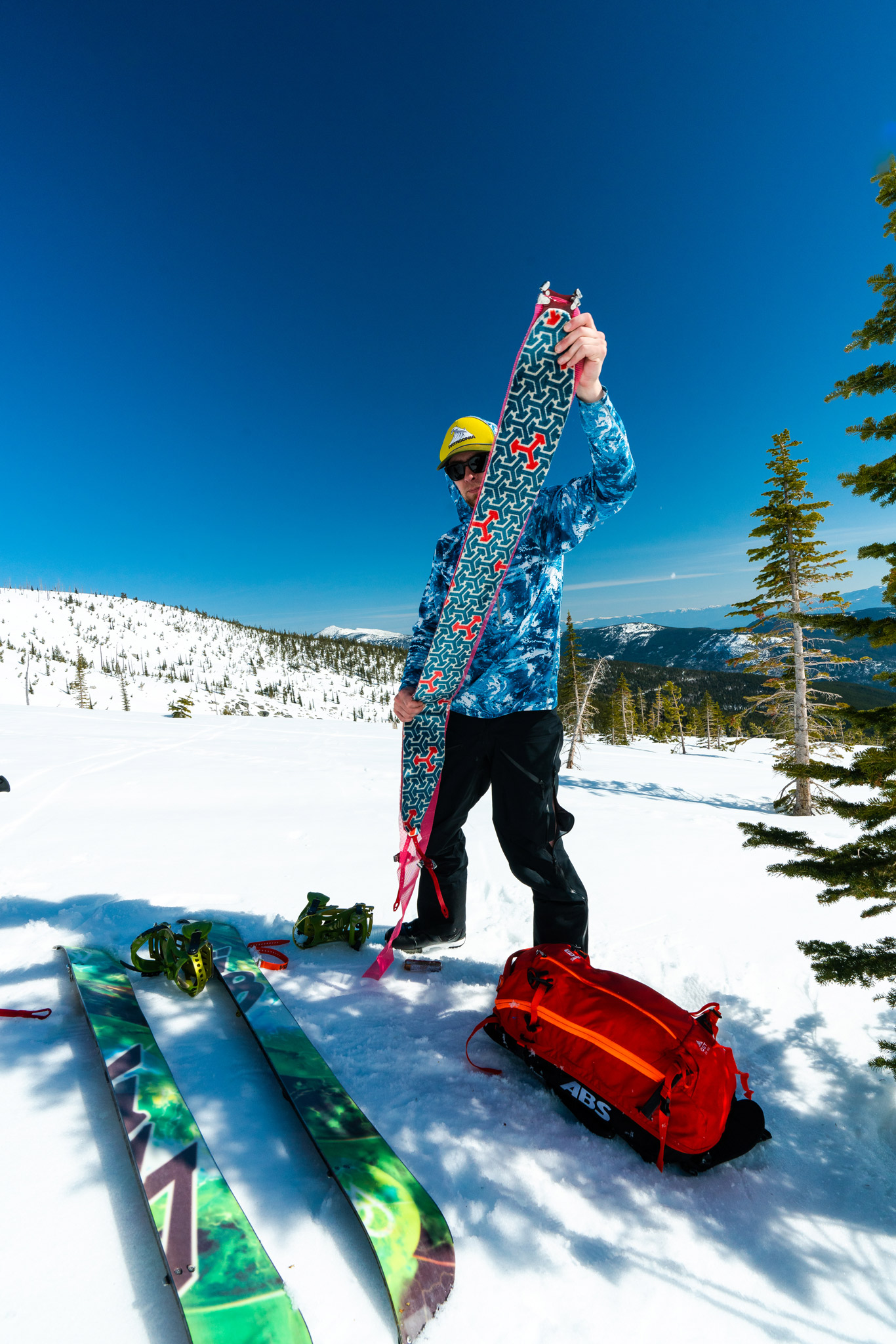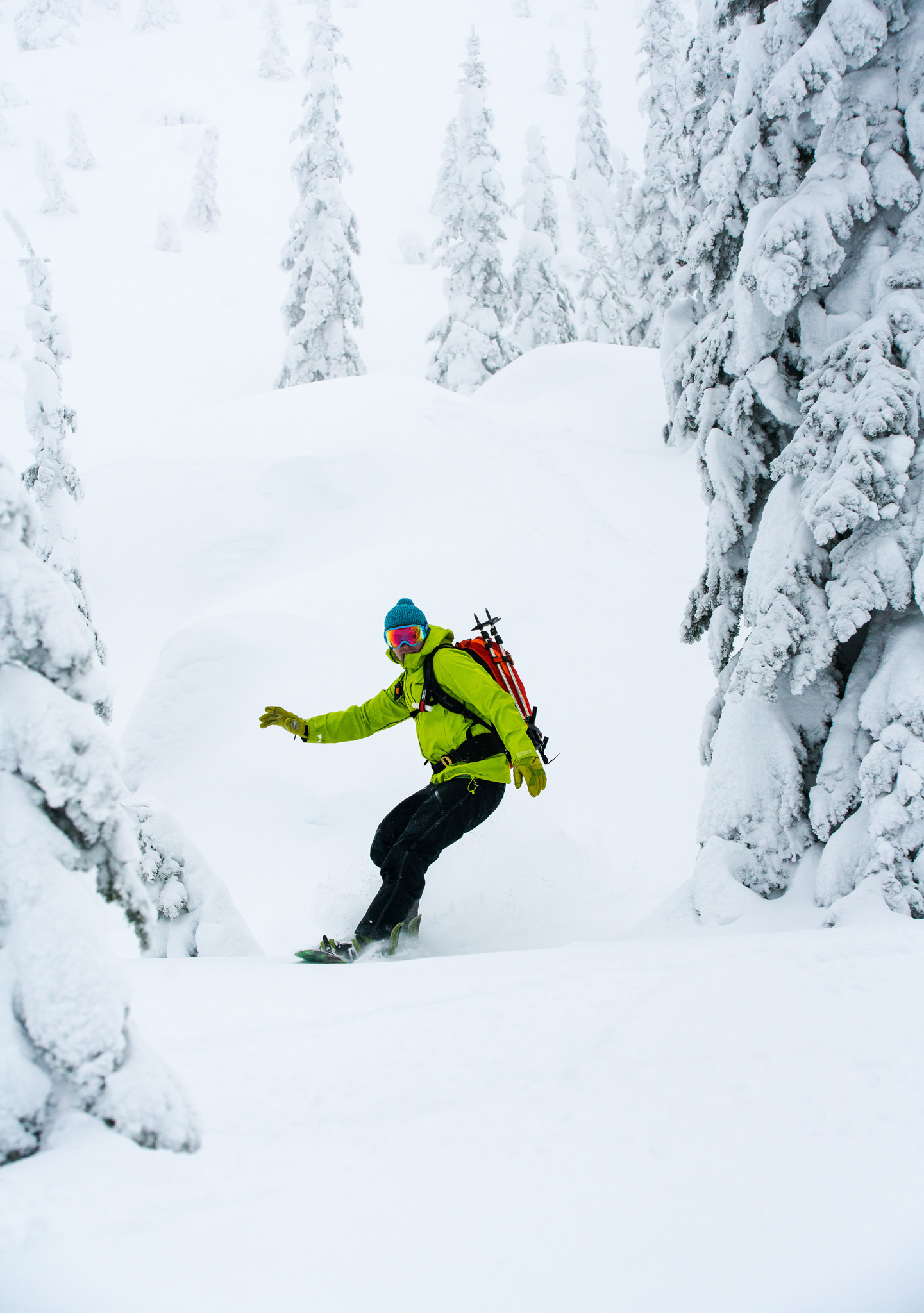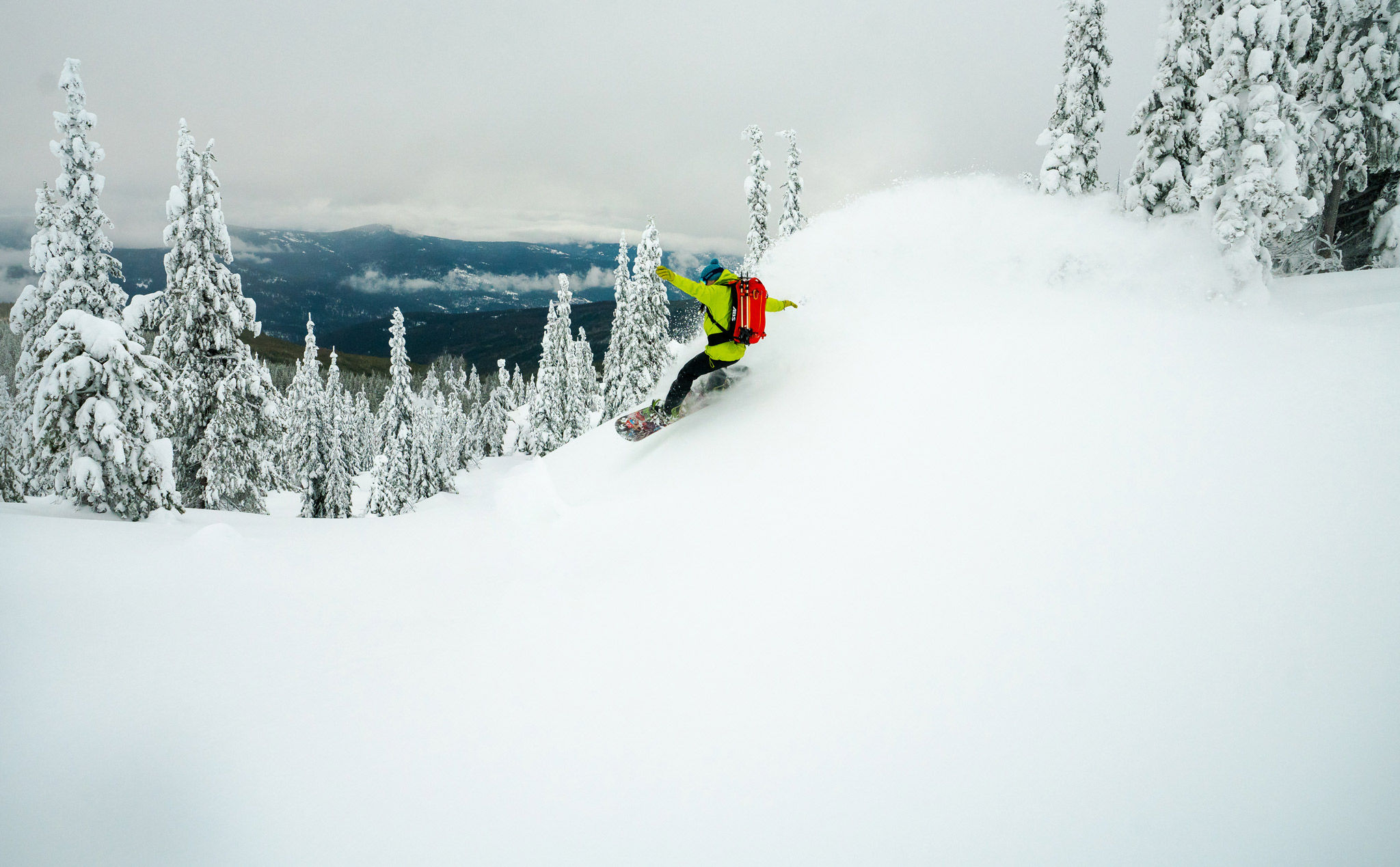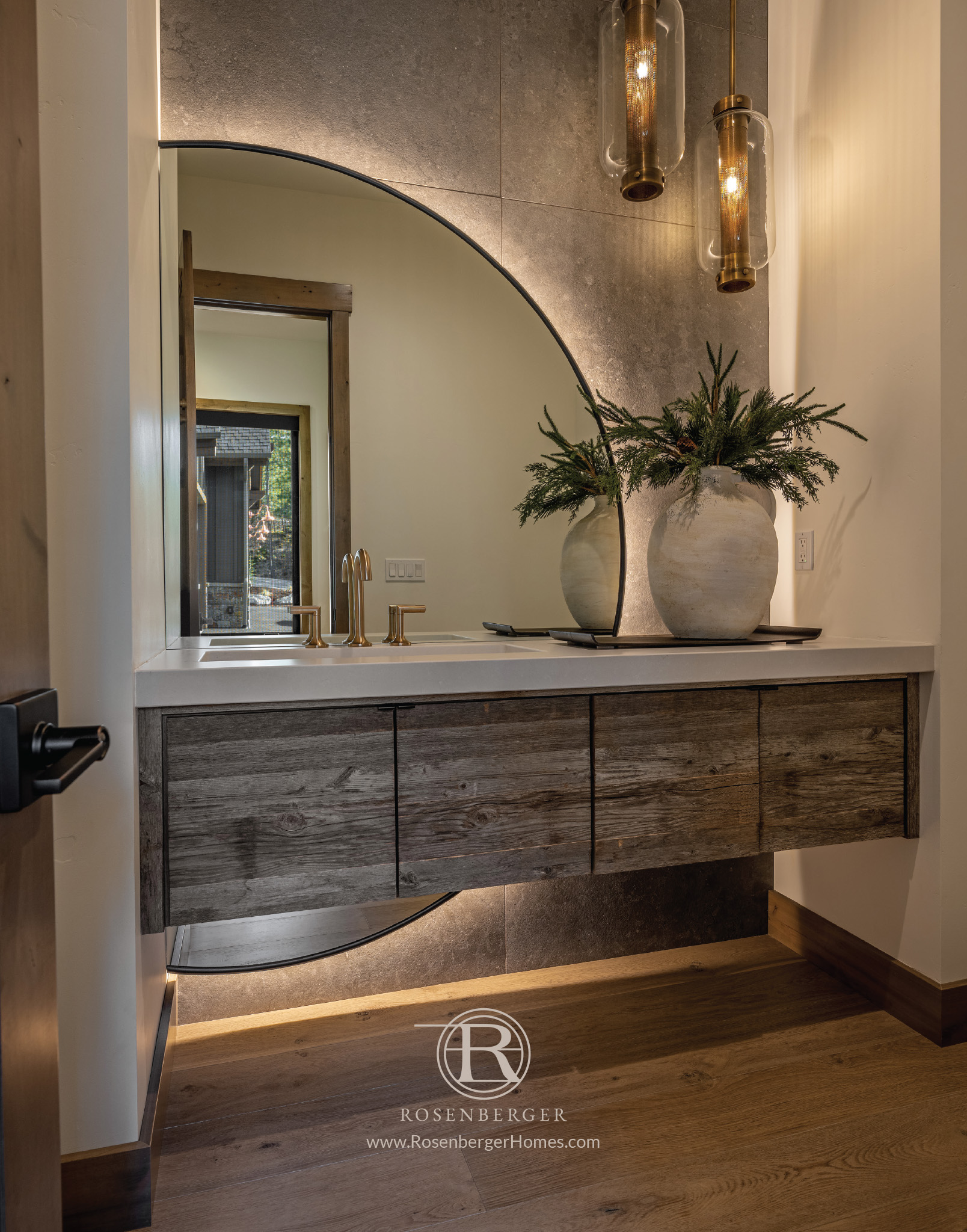Standing on top of a snow-covered ridge deep in the Idaho wilderness bright and early on a cold winter morning might not be everyone’s vision of paradise. But for snowboarder Ben Read it almost certainly is. It’s the middle of January and while most of the Inland Northwest is happily wasting away the dark and frigid morning curled deep under a thick white blanket of goose down, Ben is already halfway to the trailhead in search of a thick white blanket of a completely different nature — powder.
After a short drive and the obligatory love-hate snowmobile ride into the woods, he slides his pack onto his back. Instead of a traditional snowboard for this adventure, Ben is using his splitboard, a snowboard that breaks into two ski-like pieces to allow boarders to ascend snowy slopes just as easily as an alpine or telemark skier.

Ben straps the pieces on his boots and begins the climb. With the rhythm of his climbing skins zipping through the snow, the cares of the world seem to dissipate. The smile on his face grows a bit with each stride farther into the crisp winter wonderland. As the sun sparkles off the snow-capped ridgelines in the distance, the splitboarding climb to the top of Jeru Peak in Idaho’s Selkirk Mountains just east of Priest Lake now seems more than worth the effort he put in getting to this somewhat remote location.
For Ben, his splitboard becomes a magic carpet of sorts to transport him to terrain he used to only dream about. Skins now stripped off and the board back in its one-piece riding mode, Ben finally drops in. As he carves one turn after another into the untouched canvass of powder, his grin continues to grow until it reaches all the way from one ear to the other.
BETTER BOARDING
Ben and many snowboarders around the globe are embracing years of advances in the functionality of splitboarding technology to help them access the quiet spirituality found in remote mountain locations.
Another local snowboarder who is loving splitboards as a way to conquer new adventures is Spokane Fire Department Lieutenant and backcountry helicopter/snow cat guide Jason Keen. Like so many others before him, Jason started out accessing snowboard backcountry lines using snowshoes and found it to be miserable.
“Splitboarding changed my life,” he says. On a typical day off, Jason, like Ben, can often be found throwing up walls of fresh white powder in the nearby Selkirks. But he also likes to use his splitboard to take him on other unique adventures.

One of his favorite trips was summiting three volcanoes on three consecutive days with a friend. Mt. St. Helens on day one, Mt. Adams on day two and Mt. Hood on day three.
On any given tour, Jason loves that splitboarding can elevate you to “ride the dream powder that everyone sees in ski movies.”
Splitboarding hasn’t always been as fun and efficient as it is nowadays, however. In the not-so-distant past snowboarders who wished to trek out onto the path less traveled were stuck with two options: boot packing straight up a slope or strapping on a somewhat cumbersome pair of snowshoes and winding their way up to the top.
Story continues after a quick message from our sponsor below.
Of the two, snowshoeing always seemed the better choice but also came with some significant drawbacks. One problem was that the snowshoes themselves left a much deeper and less smooth uphill track than did alpine ski touring set-ups, thus making snowshoers a less than preferred touring partner to their friends who skied.
Another problem was that since the snowshoes are on your feet on the way up but on your back on the way down, one always had to have something large and somewhat cumbersome strapped to their back, which could create problems when trying to skin up or ride down between tight trees.
BIRTH OF THE SPLITBOARD
Thankfully in the early 90’s a snowboarder from Utah named Brett “Kowboy” Kobernik decided to hacksaw a snowboard in half, put it back together with parts from a local hardware store, and attach a set of climbing skins, thus creating the first-ever splitboard.

Realizing that his invention needed to be perfected and delivered to a wider audience, Kowboy took his early prototype to Mark Wariakois, founder of Voile, a Utah-based ski manufacturer. He convinced him to take an interest in refining the early design into something that could be marketed to the general public. In the mid 90’s Voile released the first-ever do-it-yourself kit for building a splitboard, and backcountry snowboarders around the globe were thrilled.
Despite this major development, however, splitboarding was still slow to catch on. Many snowboarders found the conversion kit to be too difficult and time consuming to assemble, and the transition from splitboard to snowboard then back again was too complicated in the deep snow of backcountry.
LEVELING THE FIELD
Now, some 20 or so years later, technology has upped the splitboard game to make them every bit as functional as a pair of backcountry skis. Major snowboard manufacturers are now fully on board with companies such as Burton, Arbor, Lib Tech, Capita and Jones, producing dedicated splitboard models alongside numerous other smaller companies.
In fact, a simple Google search of splitboards will produce scores of articles breaking down the best splitboards for different types of riders and conditions. These modern splitboards employ technology such as a rocker for better floatation, special core construction to reduce uphill climb weights, bamboo stringers to absorb chatter, and high-end sintered bases to speed up descents. Many well-known pro snowboarders even have their own signature models these days such as Arbor’s Bryan Iguchi Pro and Jeremy Jones’s Jones Mountain Twin.
The advances in splitboard technology have made it much easier for local splitboarders such as Ben and Jason to climb and ride into many of the pristine, powder-covered backcountry slopes found in and around Northern Idaho, Eastern Washington and Western Montana.

The easier use of today’s split-boards has also led to an increase of riders heading into the backcountry. And while Ben and Jason love to tour with other splitboarders, they all agree that the brotherhood of the backcountry bridges whatever minimal animosity might still exist between some snowboarders and skiers. After all, when you’re standing on top of a majestic snow-covered peak looking down at all the glorious powder just begging you to lay down fresh tracks, does it really matter how you got there?
A little farther north, epic backcountry snowcat operation Baldface, located in the mountains outside of Nelson, B.C., which caters to snowboarders and skiers alike, has been able to take advantage of the advancement in splitboard technologies to enable them to employ many guides who are snowboarders.
The much more efficient switch over of the new bindings and boards enables their guides to make the necessary quick change from riding to climbing mode when needed in rescue scenarios. In the words of Baldface owner and legendary snowboard advocate Jeff Pensiero, “splitboards are essential equipment for the guides at Baldface.”
What’s clear today is that splitboard advances have rightfully put snowboarders squarely in step with skiers when it comes to backcountry access. Gone are the days of trudging uphill on snowshoes that broke the spirit of many a backcountry snowboarder. These days it’s lighter, faster and easier for splitboarders to climb higher, travel farther, slay more powder and have more fun than ever before. N
By John Grollmus
Photography By Chris Celentano



